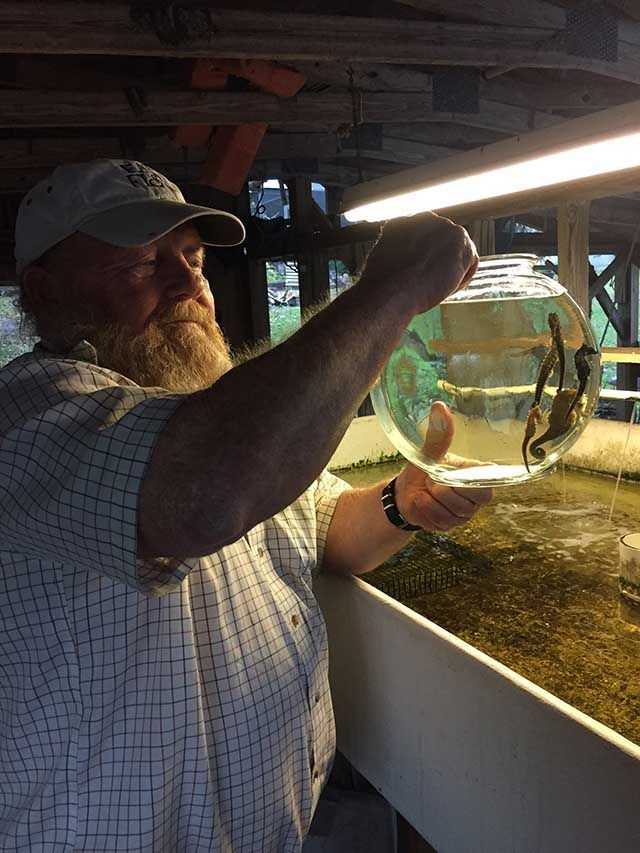
Have you ever pulled up a crab trap or baitfish cage and been greeted by everyone’s favorite Dr. Seuss-worthy fish – the seahorse? If so, you could play an important part in an ongoing seahorse genetics study being run by marine biologist Nancy Pham Ho from Florida Institute of Technology’s Vero Beach Marine Laboratory. Nancy is enlisting the help of “Citizen Scientists” just like you to help collect DNA samples from local seahorses. Using a tiny snip of seahorse fin tissue (don’t worry – the fins grow right back), Nancy is able to figure out how seahorses from different parts of our coast are related to each other. Think of it as a seahorse family tree.
From a conservation perspective, understanding how seahorse populations from different areas are linked together is critical. Since adult seahorses don’t move around a whole lot, long-distance dispersal is probably restricted to the first few months of a seahorse’s life – a time when the babies are adrift in ocean currents. It’s impossible to put a satellite tracking tag on a half-inch long baby seahorse, so looking at genetic relationships between different geographic areas is one of the best ways to identify just how far little seahorses drift before they settle into a permanent home.
So why put all of this effort into an inconspicuous fish that hardly anyone ever sees? Globally, seahorse populations are being threatened by human activities. The Chinese Traditional Medicine trade, which would have you believe that dried seahorses possess some “magical” medicinal powers (yeah, sure they do!), is responsible for the harvest of more than 20 million seahorses each year! Additional seahorses are removed from the wild to be sold as aquarium pets or knickknacks and curios in beachside souvenir shops, or as bycatch in the shrimp trawling industry. Because seahorses are slow to reproduce, this level of harvest is not sustainable.

The estuaries and coastal areas that seahorses call home are among the most threatened ecosystems on the planet. Florida’s estuaries are home to three species of seahorse – the lined seahorse, the longsnout seahorse, and the dwarf seahorse. All three species rely on healthy seagrass beds – the same habitats that provide shelter for shrimp, crabs, and many of our favorite gamefish. In the Indian River Lagoon, these habitats – and all of the animals that rely on them – are being destroyed by nutrient-rich freshwater discharges. Nancy’s genetic work will help us understand whether healthy seahorse populations might be able to “reseed” areas that have been decimated by harmful algae blooms or seagrass die-off’s, while potentially giving us some idea of where new settlers are coming from. With this information, we may be able to better protect key estuarine habitats.
So what can you do to help? First, if you catch a seahorse, pop it into a bucket with an aerator, and email Nancy at npham2010@fit.edu. She’ll walk you through the simple DNA collection process, and help you get the seahorse back to its home as quickly as possible. Second, avoid buying dead seahorses, whether as curios, knickknacks, nautical decorations, or for “medicinal” purposes. Third, if you want to try your hand at keeping seahorses in an aquarium, be sure to purchase captive-bred animals. Finally, become a vocal advocate for improved water quality in our local estuaries! The exact same issues that are negatively affecting seahorses – freshwater inflow, algae blooms, and seagrass die-off – are also ruining our inshore fisheries, putting charter captains out of business, and permanently altering Florida’s fragile coastal waters.
Come celebrate Earth Month at Florida Oceanographic Society’s Coastal Center in Stuart. Join us on Earth Day, Wednesday, April 22, for a volunteer-driven oyster shell bagging event as part of Florida Oceanographic’s long-term oyster reef restoration efforts. Additionally, you and your family can enjoy half-price admission to the Coastal Center on Earth Day. Visit www.floridaocean.org for more information.
Zack Jud, Ph.D., is the Director of Education at Florida Oceanographic Society. He is a coastal ecologist (researching tarpon, snook, bonefish, permit, and lionfish), a marine science educator, and a fly casting and fly tying instructor. Zack can be reached at zjud@floridaocean.org.